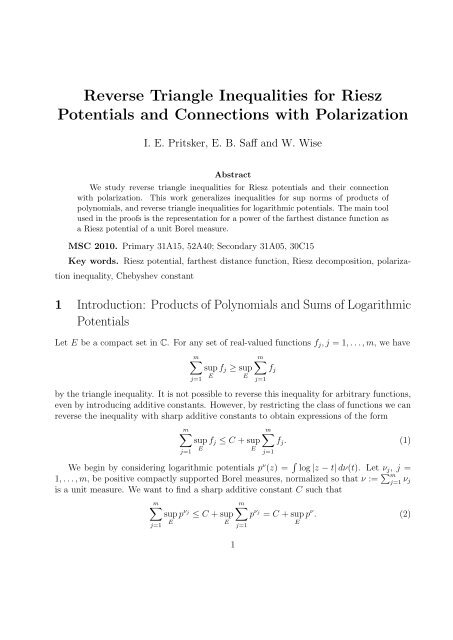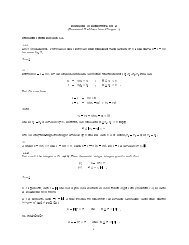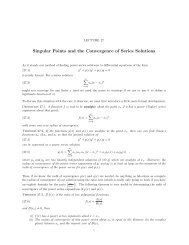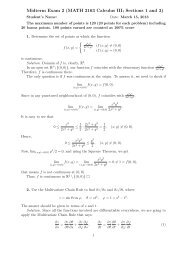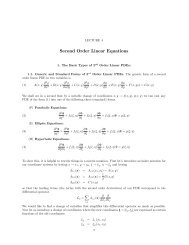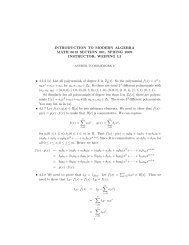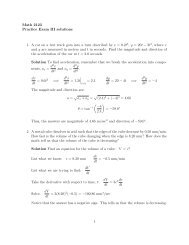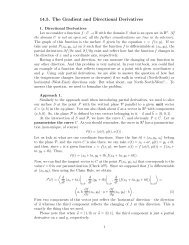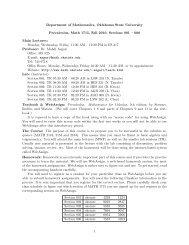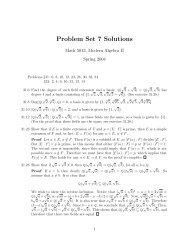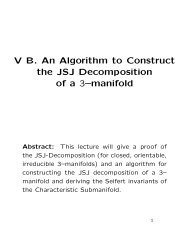Reverse Triangle Inequalities for Riesz Potentials and Connections ...
Reverse Triangle Inequalities for Riesz Potentials and Connections ...
Reverse Triangle Inequalities for Riesz Potentials and Connections ...
Create successful ePaper yourself
Turn your PDF publications into a flip-book with our unique Google optimized e-Paper software.
<strong>Reverse</strong> <strong>Triangle</strong> <strong>Inequalities</strong> <strong>for</strong> <strong>Riesz</strong><strong>Potentials</strong> <strong>and</strong> <strong>Connections</strong> with PolarizationI. E. Pritsker, E. B. Saff <strong>and</strong> W. WiseAbstractWe study reverse triangle inequalities <strong>for</strong> <strong>Riesz</strong> potentials <strong>and</strong> their connectionwith polarization. This work generalizes inequalities <strong>for</strong> sup norms of products ofpolynomials, <strong>and</strong> reverse triangle inequalities <strong>for</strong> logarithmic potentials. The main toolused in the proofs is the representation <strong>for</strong> a power of the farthest distance function asa <strong>Riesz</strong> potential of a unit Borel measure.MSC 2010. Primary 31A15, 52A40; Secondary 31A05, 30C15Key words. <strong>Riesz</strong> potential, farthest distance function, <strong>Riesz</strong> decomposition, polarizationinequality, Chebyshev constant1 Introduction: Products of Polynomials <strong>and</strong> Sums of Logarithmic<strong>Potentials</strong>Let E be a compact set in C. For any set of real-valued functions f j , j = 1, . . . , m, we havem∑j=1sup f j ≥ supE Eby the triangle inequality. It is not possible to reverse this inequality <strong>for</strong> arbitrary functions,even by introducing additive constants. However, by restricting the class of functions we canreverse the inequality with sharp additive constants to obtain expressions of the <strong>for</strong>mj=1m∑j=1m∑j=1sup f j ≤ C + supEEf jm∑f j . (1)We begin by considering logarithmic potentials p ν (z) = ∫ log |z − t| dν(t). Let ν j , j =1, . . . , m, be positive compactly supported Borel measures, normalized so that ν := ∑ mj=1 ν jis a unit measure. We want to find a sharp additive constant C such thatm∑sup p ν jm∑≤ C + sup p ν j= C + sup p ν . (2)EEE1j=1j=1
The motivation <strong>for</strong> such inequalities comes from inequalities <strong>for</strong> the norms of productsof polynomials. Let P (z) = ∏ nj=1 (z − a j) be a monic polynomial. Then log |P (z)| =n ∫ ∑log |z − t|dτ(t), where τ = 1 nn j=1 δ a jis the normalized counting measure of the zeros ofP , with δ aj being the unit point mass at a j . Let ||P || E be the uni<strong>for</strong>m (sup) norm on E.Then <strong>for</strong> polynomials P j , j = 1, . . . , m, inequality (2) can be rewritten as∣∣ m∏∣∣∣∣ ∣∣∣∣ ∏ m||P j || E ≤ M nj=1j=1P j∣ ∣∣∣∣∣ ∣∣∣∣E(3)where M = e C <strong>and</strong> n is the degree of ∏ mj=1 P j.Kneser [13] found the first sharp constant M <strong>for</strong> inequality (3). Let E = [−1, 1] <strong>and</strong>consider only two factors so that m = 2. Then (3) holds with the multiplicative constantM = 2 n−1ndeg P∏ 1k=1(1 + cos 2k − 12n π ) 1deg P 2n ∏k=1(1 + cos 2k − 1 ) 12n π n. (4)The Chebyshev polynomial shows that this constant is sharp. A weaker result was previouslygiven by Aumann [2]. Borwein [6] provided an alternative proof <strong>for</strong> this constant (4). Heshowed further that on E = [−1, 1], inequality (3) holds <strong>for</strong> any number of factors m withmultiplicative constantM = 2 n−1n[ n 2∏]k=1(1 + cos 2k − 1 ) 22n π n. (5)Another series of such constants were found <strong>for</strong> E = D, the closed unit disk. Mahler[16], building on a weaker result by Gelfond [11, p. 135], showed that (3) holds <strong>for</strong>M = 2. (6)While the base 2 cannot be decreased, Kroó <strong>and</strong> Pritsker [14] showed that <strong>for</strong> m ≤ n, we canuse M = 2 n−1n . Furthermore, Boyd [8, 7] expressed the multiplicative constant as a functionof the number of factors m, <strong>and</strong> found( ∫m π/m(M = exp log 2 cos t π2) ) .0This constant is asymptotically best possible <strong>for</strong> each fixed m as n → ∞.For general sets E, the constant M E depends on the geometry of the set. Let E be acompact set of positive capacity. Pritsker [18] showed that a sharp multiplicative constantin (3) is given byM E = exp (∫ log d E (z)dµ E (z) ),cap(E)where µ E is the equilibrium measure of E <strong>and</strong> d E is the farthest distance function defined byd E (x) := sup t∈E |x − t|, x ∈ C. Note that this constant generalizes several previous results.2
We can calculate that M [−1,1] ≈ 3.20991, which is the asymptotic version of Borwein’s constantfrom (5) as n → ∞. For the closed unit disk, we obtain M D = 2, which is the constantgiven by Mahler (6). Furthermore, Pritsker <strong>and</strong> Ruscheweyh [20, 21] showed that M D is alower bound on M E <strong>for</strong> any compact E with positive capacity. They also conjectured thatM [−1,1] is an upper bound <strong>for</strong> all non-degenerate continua. Shortly afterward, Baernstein,Pritsker, <strong>and</strong> Laugesen [3] showed M [−1,1] is an upper bound <strong>for</strong> centrally symmetric continua.The assumption that E has positive capacity is vital. For example, if E is a finiteset, then no inequality of the <strong>for</strong>m (3) is possible <strong>for</strong> any number of factors m ≥ 2. If E iscountable, then the constant M could grow arbitrarily fast as m grows large.All results <strong>for</strong> M in (3) apply as well to C in (2) with C = log M, see [22]. Specifically,(2) holds with sharp additive constant∫C E = log d E (z)dµ E (z) − log cap(E).It follows from [20, 21] that C D = log 2 is a lower bound <strong>for</strong> C E <strong>for</strong> any compact set E withpositive capacity, while C [−1,1] ≈ log 3.20991 is an upper bound on C E <strong>for</strong> certain classes ofsets E. Allowing the constant to be dependent on the number of terms m, Pritsker <strong>and</strong> Saff[22] found that (2) holds <strong>for</strong> m terms with∫C E (m) = maxc k ∈∂Elog max1≤k≤m |z − c k|dµ E (z) − log cap(E).Note that lim m→∞ C E (m) = C E .These results were generalized to Green potentials by Pritsker [19]. Let p j , j = 1, . . . , m,be Green potentials [1, p. 96] on a domain G ⊂ C. Then <strong>for</strong> any compact set E ⊂ G wehavem∑j=1infEp j ≥ C + M infEm∑p j (7)where M <strong>and</strong> C are given in [19] as explicit constants depending only on G <strong>and</strong> E, <strong>and</strong> Cis sharp.The outline of the present paper is as follows. In the next section we prove a reversetriangle inequality analogous to (7) <strong>for</strong> <strong>Riesz</strong> potentials (see Theorem 2.3), <strong>and</strong> give severalexamples. The main ingredient in the proofs is the representation of a power of the farthestdistance function as the <strong>Riesz</strong> potential of a positive unit measure (see Theorem 2.2), whichmay be of independent interest. We consider connections of the reverse triangle inequalitywith polarization inequalities <strong>for</strong> <strong>Riesz</strong> potentials in Section 3. Section 4 contains all proofs.2 <strong>Riesz</strong> <strong>Potentials</strong> <strong>and</strong> the Distance FunctionWe now consider a compact set E ⊂ R N , N ≥ 2, <strong>and</strong> <strong>Riesz</strong> potentials of the <strong>for</strong>m U µ α(x) =∫|x − t| α−N dµ(t) <strong>for</strong> 0 < α ≤ 2. For α = 2, these are Newtonian potentials, <strong>and</strong> they aresuperharmonic in R N , N ≥ 3. If N = α = 2 then one may study inequalities <strong>for</strong> logarithmic3j=1
potentials as done in [22]. We do not consider the case N = α = 2 in this paper. For 0 < α
everywhere, <strong>and</strong> we may apply the <strong>Riesz</strong> Decomposition Theorem <strong>for</strong> Newtonian potentials.It states that there exists a unique Borel measure σ 2 such that∫d 2−NE(x) = |x − t| 2−N dσ 2 (t) + h(x),. Since d 2−NE(x) is positive <strong>and</strong> tendsis a Newtonianpotential. The complete proof of Theorem 2.2 is given in Section 4.In the Newtonian case, we can also give explicit examples of σ 2 . If B is the unit ball <strong>and</strong>d B (x) = |x| + 1, then the measure σ B is found using the Laplacian. Specifically, dσ B (x) =where h is the greatest harmonic minorant of d 2−NEto zero as x → ∞, h must be identically zero [1, p. 106] <strong>and</strong> hence d 2−NE∆d 2−NB(x) = c|x|N−2 d −NBdS where c is a constant <strong>and</strong> dS is the surface area measure onthe unit sphere. If L = [−1, 1] then ∆d 2−NL= 0 everywhere except on the hyperplanethat is the perpendicular bisector of the segment. It follows that σ L is supported on thathyperplane [23]. Its value can be calculated using the generalized Laplacian, <strong>and</strong> is given bydσ L = cd −NLdS where c is a constant <strong>and</strong> dS is the surface area measure on the hyperplane[23]. For 0 < α < 2, the measure σ E should be calculated using fractional Laplacians.We are now prepared to state a reverse triangle inequality <strong>for</strong> <strong>Riesz</strong> potentials.Theorem 2.3. Let E ⊂ R N be a compact set with the minimum α-energy W α (E) < ∞,where 0 < α ≤ 2. Suppose that ν k , k = 1, . . . , m, are positive compactly supported Borelmeasures, normalized so that ν := ∑ mk=1 ν k is a unit measure, with m ≥ 2. Thenm∑k=1infEU ν kα≥ C E (α, m) + infEm∑k=1U ν kα , (9)where∫C E (α, m) := minc k ∈Emin |x − c k| α−N dµ α (x) − W α (E)1≤k≤mcannot be replaced by a larger constant <strong>for</strong> each m ≥ 2. Furthermore, (9) holds with C E (α, m)replaced by∫C E (α) := d α−NE(x)dµ α (x) − W α (E),which does not depend on m.In the Newtonian case α = 2, the minimum principle holds <strong>and</strong> so the minimum inC E (2, m) is achieved on the boundary of E. Thus∫C E (2, m) = min min |x − c k| 2−N dµ 2 (x) − W 2 (E).c k ∈∂E 1≤k≤mA closed set S ⊂ E is called dominant ifd E (x) = max |x − t| <strong>for</strong> all x ∈ supp(µ α).t∈S5
When E has at least one finite dominant set, we define a minimal dominant set D E as adominant set with the smallest number of points denoted by card(D E ). Of course, E mightnot have finite dominant sets at all, in which case we can take any dominant set as theminimal dominant set, e.g., D E = ∂E. For example, let E be a polyhedron. The vertices ofE are a dominant set, since d E (x) = max vertices t ∈ E |x − t| everywhere, not just in supp(µ α ).However, this need not be the minimal dominant set. For example, let E be a pyramid. If theapex is close to the base, then it will not be in the minimal dominant set. The hemispherehas the equator as the smallest dominant set, however this set is infinite.Corollary 2.4. For every m ≥ 2, we have C E (α, m) ≥ C E (α). In particular, if m C E (α), while C E (α, m) = C E (α) <strong>for</strong> all m ≥ card(D E ). Furthermore,the constants C E (α, m) are decreasing in m <strong>and</strong> lim m→∞ C E (α, m) = C E (α).Corollary 2.5. If E ⊂ R N is a compact set with C 1 -smooth boundary <strong>and</strong> with finitely manyconnected components, then C E (α, m) > C E (α) <strong>for</strong> all m ∈ N, m ≥ 2.If E = L := [−1, 1] ⊂ R 2 <strong>and</strong> 1 < α < 2, then d L (x) = max(|x − 1|, |x + 1|), x ∈ R 2 ,so that the endpoints <strong>for</strong>m the minimal dominant set with card(D L ) = 2. Thus C L (α) =C L (α, 2) = C L (α, m), m ≥ 2.We finish this section with several explicit examples.Example 2.6 (Unit circle T in C). Let T ⊂ C be the unit circle, <strong>and</strong> let 1 < α < 2. Weknow that dµ α (e iθ ) = dθ/2π <strong>and</strong>see [15]. We prove in Section 4 that∫minc k ∈EW α (T) = 2α−2 Γ( α−1√ π Γ( α) ,22 )min |x − c k| α−2 dµ α (x) = 2 α−2 2m ( π1≤k≤m π I 2mwhere I(x) = ∫ x0 cosα−2 θ dθ. It is obvious that d T (x) = 2, x ∈ T, <strong>and</strong> that S has no finitedominant set. There<strong>for</strong>e,C T (α, m) = 2 α−2 2m ( π)π I − 2α−2 Γ( α−1√ ) 22m π Γ( α) > C T (α) = 2 α−2 − 2α−2 Γ( α−1√ ) 22 π Γ( α) .2Example 2.7 (Unit sphere S N−1 in R N ). Let S N−1 := {x ∈ R N : |x| = 1}, N ≥ 3, <strong>and</strong> let1 < α ≤ 2. It is known that dµ α = dσ/ω N is the normalized surface area on S N−1 <strong>and</strong>W α (S N−1 ) = 2α−2 Γ( N 2√ πα−1)Γ( ) 2) ,2Γ( N+α−2see [15]. It is also clear that d S N−1(x) = 2, x ∈ S N−1 , <strong>and</strong> that S N−1 has no finite dominantset. HenceC S N−1(α, m) > C S N−1(α) = 2 α−N − 2α−2 Γ( N α−1)Γ(2√ ) 2π Γ( N+α−2 ) .26),
Example 2.8 (Unit ball B N in R N ). Let B N := {x ∈ R N : |x| ≤ 1}, N ≥ 2, <strong>and</strong> let0 < α ≤ 2. Again, B N has no finite dominant set. The Wiener constant of the ball isW α (B N ) =Γ(N−α+22)Γ( α 2 )Γ( N 2 ) ,see [15].If α = 2 <strong>and</strong> N ≥ 3 then the equilibrium measure of the ball dµ 2 = dσ/ω N is thenormalized surface area on S N−1 = ∂B N , so that d B N (x) = 2, x ∈ S N−1 = supp(µ 2 ). HenceC B N (2, m) > C B N (2) = 2 2−N − 1.If 0 < α < 2 then the equilibrium measure of the ball isdµ α (x) = Γ ( )N−α+22π N/2 Γ ( R)α−N dx<strong>for</strong> |x| < R,1 − α (R 2 − |x| 2 )α/22see [15, p. 163]. Since supp(µ α ) = B N in this case, we note that d B N (x) = 1 + |x|, x ∈ B N ,so that∫N−α+2C B N (α, m) > C B N (α) = (1 + |x|) α−N Γ( )Γ( α 2 2dµ α (x) − )Γ( N ) ,2where µ α is given above.3 <strong>Connections</strong> to Polarization <strong>Inequalities</strong>Let E be a compact set in R N <strong>and</strong> let A m = {x j } m j=1, denote an m-point subset of E. The<strong>Riesz</strong> polarization quantities, introduced by Ohtsuka [17] <strong>and</strong> recently studied by Erdélyi<strong>and</strong> Saff [9], are given byM s (A m , E) := infx∈Em∑j=1|x − x j | −s <strong>and</strong> Mm(E) s := sup M s (A m , E), s > 0.A m ⊂ELet ν j denote the normalized point mass δ xj /m, so that ∑ mj=1 ν j is a unit measure. The<strong>Riesz</strong> polarization quantity <strong>for</strong> s = N − α may be rewritten in terms of potentials asM N−α (A m , E) = m infEAs proved by Ohtsuka [17], the normalized limitm∑j=1U ν jα .M s (E) := limm→∞ M s m(E)/mexists as an extended real number <strong>and</strong> is called the Chebyshev constant of E <strong>for</strong> the <strong>Riesz</strong>s-potential. Moreover, he showed that this Chebyshev constant is always greater than orequal to the associated Wiener constant. Combining this fact with Frostman’s theorem wededuce the following:7
Proposition 3.1. For 0 < α ≤ 2 <strong>and</strong> any compact set E ⊂ R N there holdsM N−α (E) = W α (E). (10)Indeed, given a unit Borel measure µ, Frostman’s theorem <strong>for</strong> such α <strong>and</strong> E gives∫ ∫inf U α µ ≤ U α µ dµ α = U µ αα dµ ≤ W α (E),Eso that M N−α (E) ≤ W α (E), which together with Ohtsuka’s inequality yields (10). Alternatively,one can deduce (10) by observing that <strong>for</strong> the given range of α, a maximum principleholds <strong>for</strong> the equilibrium potential <strong>and</strong> appealing to Theorem 11 of Farkas <strong>and</strong> Nagy [10].Bounds on the quantity Mm N−α (E)/m <strong>and</strong> the sets A m which achieve the maximumin MmN−α (E) have been the subject of several recent papers [9, 12]. The reverse triangleinequality in Theorem 2.3 is directly connected with MmN−α (E)/m in the case of atomicmeasures. Recall that the inequality (9) holds <strong>for</strong> arbitrary positive Borel measures ν j suchthat ∑ mj=1 ν j is a unit measure. We now introduce a similar inequality where each ν j = δ xj /mis a point mass 1/m supported at x j ∈ E:1mm∑j=1inf |x − x j| α−N ≥ CE(α, δ m) + 1x∈E m infx∈Em∑|x − x j | α−N ,where CE δ (α, m) denotes the largest (best) constant such that the above inequality holds <strong>for</strong>all {x j } m j=1 ⊂ E. Clearly, we have CE δ (α, m) ≥ C E(α, m).From the definitions of CE δ N−α(α, m) <strong>and</strong> Mm(E) we immediately deduce that <strong>for</strong> allα < N,maxA m⊂E1mm∑j=1d α−NE(x j ) − M mN−α (E)mIn particular, if E is the unit sphere S N−1 ⊂ R N , we have2 α−N − M N−αm (S N−1 )mj=1≥ C δ E(α, m).= C δ S N−1 (α, m). (11)In [12], it is proved that <strong>for</strong> the unit circle T = S 1 the maximum polarization <strong>for</strong> any m ≥ 2is attained <strong>for</strong> m distinct equally spaced points. Moreover, this maximum, which occurs atthe midpoints of the m subarcs joining adjacent points is known explicitly (in finite terms)when N − α is a positive even integer, <strong>and</strong> asymptotically <strong>for</strong> all −∞ < α < N. Therebywe obtain the following.Proposition 3.2. For the unit circle T = S 1 there holds, <strong>for</strong> all −∞ < α < 2,C δ T(α, m) = 2 α−2 − M 2−α (A ∗ m, T)m= 2 α−2 − M m2−α (T)m , (12)where A ∗ m = {e i2πk/m : k = 1, . . . , m}. Moreover the following asymptotic <strong>for</strong>mulas hold asm → ∞ :8
⎧2ζ(2 − α)−(2π) ⎪⎨2−α (22−α − 1)m 1−α , 1 > α > −∞ ,CT(α, δ m) ∼ − 1 π log m , α = 1 ,⎪⎩ 2 α−2 − 2α−2 Γ ( (13))α−12√ π Γ ( ) = Cα T (α) , 1 < α < 2,2where ζ(s) denotes the classical Riemann zeta function <strong>and</strong> a m ∼ b m means that lim m→∞ a m /b m =1.For 1 < α < 2, we have from Example 2.6 <strong>and</strong> (13) that, <strong>for</strong> each m ≥ 1,C T (α) < C T (α, m) ≤ C δ T(α, m),with equality holding throughout in the limit as m → ∞. Consequently, from the <strong>for</strong>mulasin Example 2.6 we have(MmN−α (T)= 2 α−2 −C δmT(α, m) ≤ 2 α−2 −C T (α, m) = W α (T)+2 α−2 1 − 2m ( π) )π I < W α (T).2mWe remark that the inequality MmN−α (T) ≤ mW α (T) was found by a different method in(3.7) of [9].Utilizing (12) <strong>and</strong> the polarization <strong>for</strong>mulas in [12], we list the first few explicit <strong>for</strong>mulas<strong>for</strong> CT δ (α, m) that hold whenever α is a nonpositive even integer <strong>and</strong> m ≥ 1:C δ T(0, m) = 1 4 − m 4 ,C δ T(−2, m) = 1 16 − m 24 − m348 ,C δ T(−4, m) = 164 − m120 − m3192 − m5480 .For the unit sphere in higher dimensions, we have the following.Proposition 3.3. For the unit sphere S N−1 , N > 2, in R N equation (11) holds <strong>for</strong> all−∞ < α < N. Moreover, the following asymptotic <strong>for</strong>mulas hold as m → ∞ :⎧( ) (N−α)/(N−1) Γ(N/2)−σ(N − α, N − 1)m 1−α⎪⎨2π N/2N−1 , 1 > α > −∞ ,C δ S(α, m) ∼N−1 − log m Γ(N/2)√ π (N − 1)Γ((N − 1)/2) , α = 1 ,⎪⎩ 2 α−N − W α (S N−1 ) = C S N−1(α) , 1 < α < N,(14)where σ(N − α, N − 1) is a positive constant that depends only on α <strong>and</strong> N (cf. [5]), <strong>and</strong>where the <strong>for</strong>mulas <strong>for</strong> W α (S N−1 ) <strong>and</strong> C S N−1(α) are given in Example 2.7.9
For the unit ball we have the following result.Proposition 3.4. For the unit ball B N in R N there holds, <strong>for</strong> all −∞ < α < N,1 − M N−αm (B N )mMoreover the following asymptotic <strong>for</strong>mulas hold as m → ∞ :≥ C δ B(α, m) ≥ 2 α−N − M m N−α (B N ). (15)Nm⎧( ) (N−α)/N⎪⎨Γ(1 + N/2)C δ −σ(N − α, N)m −α/N , 0 > α > −∞ ,B(α, m) ∼π N⎪⎩N/2 − log m , α = 0 ,(16)where σ(N − α, N) is a positive constant that depends only on α <strong>and</strong> N.We remark that asymptotic <strong>for</strong>mulas similar to those in Proposition 3.4 can be obtained<strong>for</strong> C δ E (α, m) <strong>for</strong> a large class of N-dimensional subsets of RN by appealing to the results in[4] <strong>and</strong> [5].4 ProofsWe begin with a lemma that will be used in the proof of Theorem 2.3. Let F n = {x k,n } n k=1be a set of n points in E. Let τ n be their normalized counting measure <strong>and</strong> let 0 < α < N.We define the discrete α-energy of τ n byE α [τ n ] :=2n(n − 1)∑1≤j
Since supp(µ α ) ⊂ E, this impliesinfEU τ nα≤ W α (E).On the other h<strong>and</strong>, <strong>for</strong> the (n + 1)-tuple (x, ξ 1,n , . . . , ξ n,n ) ⊂ E we may again apply theextremal property of F n to obtain∑1≤j
<strong>for</strong> the averaging measure ε (r)α used in the definition of α-superharmonicity in [15, p. 112].Furthermore, Property (i) [15, p. 114] <strong>for</strong> α-superharmonic functions gives thatUασα(x) = lim Uασα∗ ε (r)α (x) = lim d α−Nr→0 r→0E∗ ε (r)α (x) = d α−NE(x), x ∈ R N ,where we used the fact that ε (r)α∗→ δ 0 as r → 0 [15, p. 112] on the last step.We now consider the mass of the measure σ α . Assume, without loss of generality, thatthe origin is a point in E. Consider the ball B(R) of radius R > diam(E) about the origin.We average∫d α−NE(x) = |x − t| α−N dσ α (t)R Nwith respect to the α-equilibrium measure τ R of the ball B(R), to obtain∫∫ ∫M(R) := d α−NE(x)dτ R (x) = |x − y| α−N dσ α (y)dτ R (x). (17)B(R)B(R) R NWe begin with the case α = 2, <strong>for</strong> which the α-equilibrium measure is the normalizedsurface area measure dτ R = dx/(ω N R N−1 ). It is a st<strong>and</strong>ard fact [1, p. 100] that the potentialof the equilibrium measure is given byU τ R2 (x) =∫1ω N R N−1|x − t| 2−N dt ={R 2−N if |x| ≤ R,|x| 2−N if |x| > R.Consider the left h<strong>and</strong> side of (17). We know R ≤ d E (x) ≤ R + diam(E) on supp(τ R ) =∂B(R). Thus(R + diam(E)) 2−N ≤ M(R) ≤ R 2−N . (18)On the other h<strong>and</strong>, we may apply Tonelli’s Theorem to the right h<strong>and</strong> side of (17) <strong>and</strong>obtain∫ ∫∫|x − t| 2−N dσ 2 (t)dτ R (x) = |x − t|∂B(R) R∫R dτ R (x)dσ 2 (t)N ∂B(R)∫= U τ R2 (y)dσ 2 (y)∫R N ∫= U τ R2 (t)dσ 2 (t) + U τ R2 (t)dσ 2 (t)|t|R= R 2−N σ 2 (B(R)) + U τ R2 (t)dσ 2 (t).Since 0 < U τ R2 (t) < R 2−N <strong>for</strong> |t| > R, we have|t|>RR 2−N σ 2 (B(R)) ≤ M(R) ≤ R 2−N σ 2 (R N ).Combining the above inequality with (18) <strong>and</strong> letting R → ∞, we obtain σ 2 (R N ) = 1.12
The proof in the case of 0 < α < 2 is similar. In this case, the α-equilibrium measure isgiven in [15, p. 163] aswhere A is the constantdτ R (x) = AR α−N (R 2 − |x| 2 ) −α/2 dx <strong>for</strong> |x| < R,A =Its potential U τ R α (x) = ∫ |x − t| α−N dτ R (t) is<strong>for</strong> all |y| ≤ R [15, (A.1)]. Using the fact thatwe calculate <strong>for</strong> |y| ≤ R thatIntroducing the notationΓ ( N−α+ 1 )2π N/2 Γ ( ).1 − α 2U τ Rα (y) = AR α−N π N/2+1Γ(N/2) sin(πα/2) ,πsin(πx)U τ Γ ((N − α)/2 + 1)Rα (y) =π N/2 Γ (1 − α/2) Rα−N== Γ(x)Γ(1 − x),Γ(α/2)Γ ((N − α)/2 + 1)Γ(N/2)π N/2+1c(N, α) = AΓ(N/2) sin(πα/2)πN/2Γ(α/2)Γ(1 − α/2)Γ(N/2)R α−N .Γ(α/2)Γ ((N − α)/2 + 1)= ,Γ(N/2)we obtainU τ Rα (y) = c(N, α)R α−N , <strong>for</strong> all |y| ≤ R. (19)Furthermore, this same value serves as the upper bound of the potential <strong>for</strong> all |y| > R.Notice that c(N, 2) = 1 <strong>and</strong> hence (19) is a generalization of the fact that U τ R2 (x) = R 2−N<strong>for</strong> |x| ≤ R when α = 2.Consider the left h<strong>and</strong> side of (17). We know |x| ≤ d E (x) ≤ |x| + diam(E) in B(R). Weuse the lower bound on d E to find an upper bound on M(R). Applying the calculations in[15, Appendix] again, we conclude that∫∫d α−NE(x)dτ R (x) ≤ |x| α−N dτ R (x)B(R)B(R)∫= AR α−N (R 2 − |x| 2 ) −α/2 |x| α−N dxB(R)= AR α−N π N/2+1Γ(N/2) sin(πα/2)= c(N, α)R α−N .13
Next we use the upper bound on d E to obtain a lower bound <strong>for</strong> M(R). Let d = diam(E).Then <strong>for</strong> any ϵ > 0 we have d ≤ ϵ|x| <strong>for</strong> any x not in B(d/ϵ). Hence∫∫d α−NE(x)dτ R (x) ≥ (|x| + d) α−N dτ R (x)B(R)B(R)∫>(|x| + d) α−N dτ R (x)B(R)\B(d/ϵ)∫≥|x| α−N (1 + ϵ) α−N dτ R (x)B(R)\B(d/ϵ)∫= (1 + ϵ) α−N U τ Rα (0) − (1 + ϵ) α−N |x| α−N dτ R (x)B(d/ϵ)∫= (1 + ϵ) α−N c(N, α)R α−N − (1 + ϵ) α−N |x| α−N dτ R (x)Estimating the integral over the ball B(d/ϵ), we find∫B(d/ϵ)B(d/ϵ)∫ d/ϵ|x| α−N dτ R (x) =R α−N Aω N |x| α−1 (R 2 − |x| 2 ) −α/2 d|x|0≤R α−N (R 2 − d2ϵ 2 ) −α/2Aω N d ααϵ α .Since the above integral is also bounded below by zero, it follows that it is O(R −N ) <strong>and</strong> thus(1 + ϵ) α−N c(N, α)R α−N − O(R −N ) < M(R) ≤ c(N, α)R α−N . (20)On the other h<strong>and</strong>, we may apply Tonelli’s Theorem on the right h<strong>and</strong> side of (17) toobtain∫B(R)∫|x − y| α−N dσ α (y)dτ R (x) =R N ∫=∫=∫R N ∫U τ RαR N|y|≤R|x − y| α−N dτ R (x)dσ α (y)B(R)(y)dσ α (y)Applying the calculation of the potential in (19), we findU τ Rα (y)dσ α (y) +∫|y|>RU τ Rα (y)dσ α (y).c(N, α)R α−N σ α (B(R)) ≤ M(R) < c(N, α)R α−N σ α (R N ). (21)Combining (20) <strong>and</strong> (21), dividing by R α−N <strong>and</strong> then letting R → ∞, we obtain(1 + ϵ) α−N ≤ σ α (R N ) ≤ 1.Finally, we conclude σ α (R N ) = 1 by letting ϵ → 0.14
Proof of Theorem 2.3. For any positive Borel measure µ, the potential∫U α(t) µ = |t − x| α−N dµ(x)is lower semicontinuous [15, p. 59], <strong>and</strong> hence attains its infimum on the compact set E.Thus we may choose c k ∈ E such that<strong>for</strong> each k = 1, . . . , m. It follows thatm∑inf U ν kα =Ek=1=infEm∑k=1U ν kαm∑∫k=1= U ν kα (c k )U ν kα (c k )|c k − x| α−N dν k (x)∫≥ min |c k − x| α−N dν(x)1≤k≤m∫ () α−N= max |c k − x| dν(x).1≤k≤mThe function d m (x) := max 1≤k≤m |c k − x| is the farthest distance function on the setof points c k . By Theorem 2.2, there exists a probability measure σ α such that U σ αα (x) =d α−Nm (x). Applying Tonelli’s Theorem, we havem∑∫∫inf U ν kα ≥ U σ αα (x)dν(x) = Uα(t)dσ ν α (t).Ek=1We estimate the potential Uα ν on R N . Let µ α be the α-equilibrium measure <strong>for</strong> E <strong>and</strong> letW α (E) be the α-energy <strong>for</strong> E. Let g(t) := U µ αα (t) − W α (E). By Frostman’s Theorem 2.1,we know g(t) ≤ 0 everywhere. On the other h<strong>and</strong>, Uα(t) ν − inf E Uα ν ≥ 0 <strong>for</strong> t ∈ E. Thusk=1U ν α(t) ≥ infEU α ν + U µ αα (t) − W α (E)on E. It follows by the Principle of Domination [15, Theorem 1.27 on p. 110 <strong>for</strong> α = 2 <strong>and</strong>Theorem 1.29 on p. 115 <strong>for</strong> 0 < α < 2] that this inequality holds in R N . Thus, noting thatσ α is a unit measure <strong>and</strong> again applying Tonelli’s Theorem, we findm∑∫inf U ν kα ≥ Uα(t)dσ ν α (t)E≥∫ (inf= infE U ν α += infE U ν α +∫U α ν +E∫∫)U µ α(t) − W α (E) dσ α (t)Uασα(x)dµ α (x) − W α (E)d α−Nm (x)dµ α (x) − W α (E).15
By minimizing over all m-tuples c k , we conclude thatwherem∑k=1infE∫C E (α, m) := minc k ∈EU ν k≥ C E (α, m) + infEm∑U ν k,k=1min |x − c k| 2−N dµ α (x) − W α (E).1≤k≤mWe now show C E (α, m) is the largest possible constant <strong>for</strong> a fixed m. We present twoproofs of this fact. We begin with the shorter one which requires E to be regular in thesense that U µ α∫ α (x) = W α (E) <strong>for</strong> all x ∈ E. Choose a set c ∗ k , k = 1, . . . , m, such thatdα−Nm (x)dµ α (x) attains its minimum on E m . Let d ∗ m(x) := min 1≤k≤m |x−c ∗ k | <strong>and</strong> iterativelydefine the setsIt is clear thatS 1 ={x ∈ supp(µ α ) : |x − c ∗ 1| = d ∗ m(x)},S k ={x ∈ supp(µ α ) \ ∪ k−1j=1 S j : |x − c ∗ k| = d ∗ m(x)}, k = 2, . . . , m.supp(µ α ) = ∪ m k=1S k <strong>and</strong> S k ∩ S j = ∅, k ≠ j.Hence we can decompose µ α along the sets S k such thatν ∗ k := µ α | Sk <strong>and</strong> µ α =m∑νk.∗k=1If E is regular, then ∫ |x − t| α−N dµ α (t) = W α (E) <strong>for</strong> each x ∈ E by Frostman’s Theorem.Applying this fact, along with Tonelli’s Theorem, we obtainm∑k=1infEU ν∗ kα≤==m∑k=1m∑∫k=1k=1U ν∗ kα (c ∗ k)|c ∗ k − x| α−N dν ∗ k(x)m∑∫(d ∗ m(x)) α−N dνk(x)∗∫= (d ∗ m(x)) α−N dµ α (x)∫∫= (d ∗ m(x)) α−N dµ α (x) − W α (E) + inft∈Em∑= C E (α, m) + inf U ν∗ jα .Ek=1|x − t| α−N dµ α (x)16
Hence C E (α, m) is sharp. The alternative proof uses points minimizing the discrete α-energy <strong>and</strong> does not require that E be regular. Let F n = {ξ l,n } n l=1 be the points of Ewhich minimize the discrete α-energy. We will break the set F n up using the points c ∗ k justas we broke up supp(µ α ) previously. Let F k,n be a subset of F n such that ξ l,n ∈ F l,n ifd ∗ m(ξ l,n ) = |ξ l,n − c ∗ k |, 1 ≤ l ≤ n. If there is overlap between the sets, assign ξ l,n to only oneset F k,n . It is clear that <strong>for</strong> any n ∈ N,Define the measuresso that <strong>for</strong> their potentialswe haveinfEF n = ∪ m k=1F k,n <strong>and</strong> F k,n ∩ F j,n = ∅, k ≠ j.νk,n ∗ = 1 ∑δ ξl,n ,nξ l,n ∈F k,np ∗ k,n(x) = 1 ∑|x − ξ l,n | α−N , k = 1, . . . , m,nξ l,n ∈F k,np∗ k,n(x) ≤ 1 ∑|c ∗ k − ξ l,n | α−N = 1 ∑(d ∗nnm(ξ l,n )) α−N .ξ l,n ∈F k,n ξ l,n ∈F k,nIt follows from the weak ∗ convergence of ν n := ∑ mk=1 ν∗ k,n = ∑ 1 nn l=1 δ ξ l,nto µ α , as n → ∞,thatlim supn→∞m∑k=1infE1n∑p∗ k,n(x) ≤ lim (d ∗n→∞ nm(ξ k,n )) α−Nk=1∫= (d ∗ m(x)) α−N dµ α (x).Applying Lemma 4.1 to the potential p ∗ n of ν ∗ n we find thatIt follows thatlim supn→∞m∑k=1lim infn→∞ Ep∗ n = W α (E).infEp∗ n ≤ C E (α, m) + limn→∞infE p∗ n.Hence we have asymptotic equality in (9) as n → ∞ with m ≥ 2 being fixed, which showsthat C E (α, m) is the largest possible constant <strong>for</strong> each m. Since d m ≤ d E everywhere, wehave C E (α, m) ≥ C E (α).Proof of Corollary 2.4. If m < card(D E ), then there is an x 0 ∈ supp(µ α ) such that d ∗ m(x 0 ) ∫ d α−NE(x)dµ α (x) <strong>and</strong> hence C E (α, m) > C E (α). Thisargument shows that if D E is infinite, then C E (α, m) > C E (α) <strong>for</strong> m ≥ 2. If m ≥ card(D E )17
then we may choose the points c ∗ k to include D E <strong>and</strong> hence d ∗ m(x) = d E (x) <strong>for</strong> x ∈ supp(µ α ).Thus C E (α, m) = C E (α).Let c k , k = 1, . . . , m, be a set of points in E that minimize the integral in the expressionof C E (α, m). Choose a point c m+1 ∈ ∂E. Then∫C E (α, m) = min |x − c k| α−N dµ α (x) − W α (E)1≤k≤m∫≥ min |x − c k| α−N dµ α (x) − W α (E)1≤k≤m+1≥ C E (α, m + 1).Hence the constants C E (α, m) are decreasing. It remains to show that their limit is C E (α).Let {a k } ∞ k=1 be a countable dense subset of E. Then∫C E (α) ≤ C E (α, m) ≤ min |x − a k| α−N dµ α (x) − W α (E).1≤k≤mFurther, applying the Dominated Convergence Theorem, we have∫∫lim min |x − a k| α−N dµ α (x) = lim min |x − a k| α−N dµ α (x)m→∞ 1≤k≤m m→∞ 1≤k≤m∫= d α−NE(x)dµ α (x).The result follows.Proof of Corollary 2.5. We show the minimal dominant set is infinite <strong>and</strong> then the resultfollows from Corollary 2.4. Suppose to the contrary that D E = {x j } s j=1 is finite. Let J ⊂ ∂Ebe a single connected component of the boundary. DefineJ k := {x ∈ J : d E (x) = |x − x k |}, k = 1, . . . , s.For each x ∈ J k , the segment [x, x k ] is orthogonal to ∂E at x k , by the smoothness assumption.Hence, each J k is contained in the normal line to ∂E at x k , k = 1, . . . , s. We thus obtainthat J = ∪ s k=1 J k is contained in a union of straight lines which is a contradiction.Proof of Example 2.6. To calculate the quantity min ck ∈T∫min1≤k≤m |x − c k | α−N dµ α (x), wefollow an idea of Boyd [8]. Let c k = −e iψ k , k = 1, . . . , m, with ψk < ψ k+1 , <strong>and</strong> <strong>for</strong> notationalconvenience let ψ 0 = ψ m . Then we have max 1≤k≤m |e iθ − c k | = |e iθ + e iψ k | = |ei(θ−ψ k ) + 1| <strong>for</strong>18
ψ k−1 +ψ k2≤ θ ≤ ψ k+ψ k+12<strong>and</strong> hence∫min |x − c k| α−N dµ α (x) = 11≤k≤m 2π= 1 πm∑∫ ψ k +ψ k+12ψ k−1 +ψ kk=1 2∫ ψ k −ψ k−12m∑k=1= 2α−2π=2 α−2 2 π0m∑k=1∫ ψ k −ψ k−120m∑I(θ k ),k=1|e i(θ−ψ k) + 1| α−2 dθ|e iθ + 1| α−2 dθcos α−2 ( θ2)dθwhere θ k = ψ k−ψ k−1<strong>and</strong> I(θ4 k ) = ∫ θ kcos α−2 (θ) dθ. Since I(θ0 k ) is strictly convex <strong>for</strong> 0 < θ k
[3] A. Baernstein, II, R. S. Laugesen, <strong>and</strong> I. E. Pritsker, Moment inequalities <strong>for</strong> equilibriummeasures in the plane, Pure Appl. Math. Q. 7 (2011), 51–86.[4] S. V. Borodachov <strong>and</strong> N. Bosuwan, Asymptotics of discrete <strong>Riesz</strong> d-polarization onsubsets of d-dimensional manifolds, Potential Anal. (to appear).[5] S. V. Borodachov, D.P. Hardin <strong>and</strong> E.B. Saff, Asymptotics of discrete <strong>Riesz</strong> polarization<strong>for</strong> rectifiable sets, (manuscript), 2013.[6] P. B. Borwein, Exact inequalities <strong>for</strong> the norms of factors of polynomials, Canad. J.Math. 46 (1994), 687–698.[7] D. W. Boyd, Two sharp inequalities <strong>for</strong> the norm of a factor of a polynomial, Mathematika39 (1992), 341–349.[8] D. W. Boyd, Sharp inequalities <strong>for</strong> the product of polynomials, Bull. London Math. Soc.26 (1994), 449–454.[9] T. Erdélyi <strong>and</strong> E. B. Saff, <strong>Riesz</strong> polarization inequalities in higher dimensions, J. Approx.Theory 171 (2013), 128–147.[10] B. Farkas <strong>and</strong> B. Nagy, Transfinite diameter, Chebyshev constant <strong>and</strong> energy onlocally compact spaces, Potential Anal. 28 (2008) 241–260.[11] A. O. Gel’fond, Transcendental <strong>and</strong> Algebraic Numbers, Dover Publications Inc., NewYork, 1960.[12] D. P. Hardin, A. Kendall <strong>and</strong> E. B. Saff, Polarization optimality of equally spaced pointson the circle <strong>for</strong> discrete potentials, Discrete & Comp. Geometry 50 (2013), 236–243.arXiv number: 1208.5261v1.[13] H. Kneser, Das maximum des produkts zweies polynome, Sitz. Preuss. Akad. Wiss.Phys.-Math. Kl. (1934) 429–431.[14] A. Kroó <strong>and</strong> I. E. Pritsker, A sharp version of Mahler’s inequality <strong>for</strong> products ofpolynomials, Bull. London Math. Soc. 31 (1999), 269–278.[15] N. S. L<strong>and</strong>kof, Foundations of Modern Potential Theory, Springer-Verlag, New York,1972.[16] K. Mahler, An application of Jensen’s <strong>for</strong>mula to polynomials, Mathematika 7 (1960),98–100.[17] M. Ohtsuka, On various definitions of capacity <strong>and</strong> related notions, Nagoya Math. J.30 (1967), 121–127.[18] I. E. Pritsker, Products of polynomials in uni<strong>for</strong>m norms, Trans. Amer. Math. Soc. 353(2001), 3971–3993.20
[19] I. E. Pritsker, <strong>Inequalities</strong> <strong>for</strong> sums of Green potentials <strong>and</strong> Blaschke products, Bull.Lond. Math. Soc. 43 (2011), 561–575.[20] I. E. Pritsker <strong>and</strong> S. Ruscheweyh, <strong>Inequalities</strong> <strong>for</strong> products of polynomials. I, Math.Sc<strong>and</strong>. 104 (2009), 147–160.[21] I. E. Pritsker <strong>and</strong> S. Ruscheweyh, <strong>Inequalities</strong> <strong>for</strong> products of polynomials. II, AequationesMath. 77 (2009), 119–132.[22] I. E. Pritsker <strong>and</strong> E. B. Saff, <strong>Reverse</strong> triangle inequalities <strong>for</strong> potentials, J. Approx.Theory 159 (2009), 109–127.[23] W. Wise, Potential theory <strong>and</strong> geometry of the farthest distance function, PotentialAnal. (2013) published online.I. E. PritskerDepartment of Mathematics, Oklahoma State University, 401 Mathematical Sciences,Stillwater, OK 74078-1058, USAigor@math.okstate.eduE. B. SaffCenter <strong>for</strong> Constructive Approximation, Department of Mathematics, V<strong>and</strong>erbilt University,Nashville, TN 37240, USAedward.b.saff@v<strong>and</strong>erbilt.eduW. WiseDepartment of Mathematics, Oklahoma State University, 401 Mathematical Sciences,Stillwater, OK 74078-1058, USAninadawn@gmail.com21


